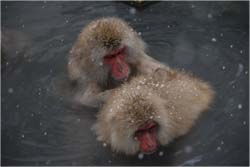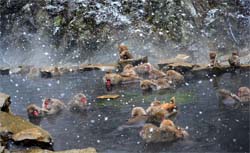
2017/5/14(日) 第36回京大モンキー日曜サロン
「なぜニホンザルは温泉に入るのか? Why do Japanese monkeys go in the hot springs?」 サユリ・タケシタ 先生
「なぜニホンザルは温泉に入るのか? Why do Japanese monkeys go in the hot springs?」 サユリ・タケシタ 先生
|
■日時:2017/5/14(日) 12:30~13:15 ■講師:サユリ・タケシタ 先生 (京都大学霊長類研究所・社会進化分野・大学院生) 長野県地獄谷のニホンザルは温泉に入ります。 この「入浴」行動は、地獄谷に野猿公苑が約50年前に設立されて以来ずっと続いており、 地獄谷のサル集団独自のものとなっています。 人間は熱い温泉に、安らぎやリウマチの治療のために入ります。 ニホンザルはなぜ温泉に入るのでしょうか? 私はニホンザルたちが温泉に入ることによってストレスが軽減しているのかどうかかを調べてみました。 調査では、長野県地獄谷野猿公苑のメスのニホンザル12頭の行動を観察し、 フンの採取をおこないました。このうちの6頭は温泉に入るサルですが、 残りの6頭は温泉に入る習慣を持ちません。 採取したフンからはストレスレベルの指標であるグルココルチコイドというホルモンの濃度の測定をし、 サルたちが温泉に入っている時間と個体間の順位との関係を調べました。 温泉に入るというニホンザルのユニークな行動と、ストレスとの関係について、詳しくお話しします。 In Nagano prefecture, a group of Japanese monkeys is known to use hot springs. This behavior started since the monkey park was established about 50 years ago, and is unique to that population of monkeys. However, the reasons for such behavior have not been elucidated. In humans, thermal spas have been widely used for therapy of some rheumatic disorders and for relaxation. In this study, I investigated whether Japanese monkeys reduce stress levels by bathing in hot springs. During spring (April to June) and winter (October to December), I collected behavioral data and fecal samples from 12 adult female Japanese monkeys living in Jigokudani Monkey Park, Nagano prefecture. Six females did not use the hot springs and the other six were regular bathers. From the fecal samples I measured glucocorticoid concentrations (GC), a stress index, and from the behavioral data I determined the time spent in the hot spring and the dominance rank. In this presentation I will explain details of this unique behavior and its effects on stress levels in Japanese monkeys. |
  
|



営業案内
友の会
園内マップ・施設紹介
アクセス

動物園イベント
モンキー日曜サロン
ミュージアムトーク
特別展
写生大会

学習利用のご案内
団体利用・実習・研修など
モンキーキャンパス
プリマーテス研究会
おうちどうぶつえん
研究室
博物館資料
連携研究
屋久島研修所
Web霊長類図鑑
霊長類和名リスト
国際学術誌「Primates」
雑誌「モンキー」
新JMC通信
歴史・定款・年報など
スタッフ紹介
全頭誕生日カレンダー
求人情報
取材等のお問合せ
サイト利用規定
| ※日本の動物園等で飼育されている霊長類の種数は102種類です。(2015年3月31日時点、GAIN調べ。種間雑種その他の分類不明なものは除く。) |












